 |
Hempstead |
|
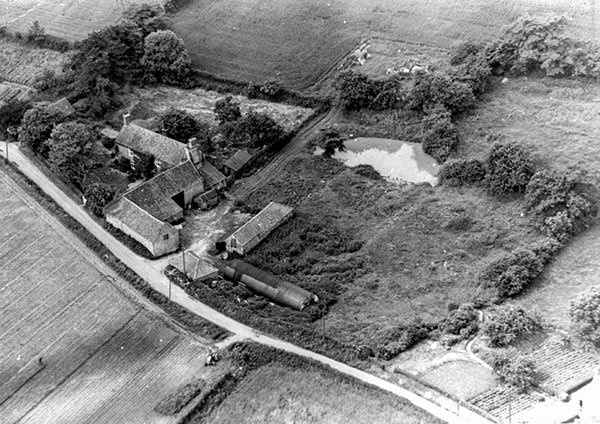 |
Brownwood Farm - 1952 Note the tractor in the foreground |
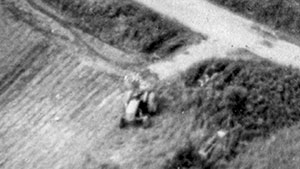 |
Tractor from above photo |
House, dated 1674 on gable. Flint with brick dressings, pantile roof, gable parapets. Single range, four bays. Internal stack to left gable. Two storeys and attic. Three 19th century cross windows, irregularly spaced, to each floor. Flint plinth with brick cap, dental cornice and oversailing eaves. Central single storied gable porch in flint and brick with pantile roof; segmental arch in moulded brick beneath square brick hood mould; brick string course; archway narrows at lower part of jambs. Porch gable has brick patternwork of zig-zags and lozenges, ball finials to apex and bases. Left hand gable in coursed flint/brick mosaic has brick patternwork of hearts and lozenges and date and date 1674; 2 square openings in attic with 8 radiating brick spokes; blocked oval openings to ground and first floor at right. 20th century rear extensions of no special interest. House attached at right to farm buildings converted to dwellings. A. Cattermole - 31st January 2006 |
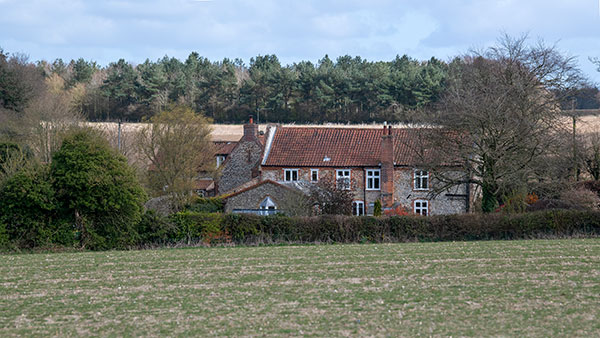 |
Brownwood Farm - 29th March 2020 The farmhouse is Grade II listed |
For the historian this is the most interesting farm in the village. It has deeds going back to 1684 - almost a complete set. However, this date is unfortunate since it is pre-dated by the 1674 which appears on the south gable end of the house - though of course that date could have been put up on a later rebuilding. Brownwood has remained a single independent small farm for three centuries, unlike the other village farms many of which have amalgamated with their large neighbours. Its legal title consisted partly of freehold title, partly copyhold of the Manor of Hempstead Netherhall and partly copyhold of the Manor of Hempstead Losehall. This meant three sets of documents every time there was a death or change of ownership - a veritable lawyers’ delight. There were eleven named closes or fields on the 50 acre farm, each one of which had to be minutely described on every document of title. |
In the 17th Century Brownwood Farm belonged to the Gotts family, passing under the Will of Nicholas Gotts dated July 24th 1684 mostly to his son Owen Gotts but part to his second son, also called Nicholas, Nicholas Gotts had a large family and much wealth and his will is worth reading - the Grand of Probate attaching to it still being expressed in Latin. The form of a will of a rich farmer (apparently a widower) three hundred years ago is not all that different from the form of a modern will. The difference lies in the fact that wealth lay in the land and cash was short. Accordingly Nicholas Gotts being “sick in body but of sound and disposing memory”, blessed with eight children, gave most of his land to his son Owen, imposing on him the duty to provide legacies, income and apprenticeship fees for his younger brothers and sisters, adding that if he failed to carry out these obligations the land would pass to his next brother on the same conditions. There is a meticulous description of each field or close referring to some purchased from Roger Brettingham and from the Abbs family. Nicholas then goes on to his personal estate and gives each child a ring or piece of silver or spoon and ''the little box which Mr Wilson gave me”. (Was this the Peter Wilson who married Alice Britiffe?) Nicholas directs that his ''Surplusage” - cash and goods - is divisible between his two daughters “without grudging”. Whether or not the children were likely to be quarrelsome is not known but the Testator referring to his Supravisor says ''and it is my request to him that he will advise my children to live in love and to deal justly and lovingly by each of the others”. In particular Mary had to hand over to James Tower: The document is witnessed by Robert Britiffe. What happened to Mary is not known but Nicholas Gotts's family must have retained his share of the land because in 1695 Nicholas Gotts junior of North Walsham sold to Peter Drury a tailor. Peter Drury died and Probate of his will was granted on July 20th 1705 for the benefit of widow Elizabeth. In this will, as in Edmond Brightman’s will, the legacies have to be paid “within the south porch of the Parish Church of Hempstead.'' The Drury Executors held the land for fourteen or so years and then sold to James Tower the younger of Edgefield - the son of the money lender who had apparently foreclosed on the unfortunate widow Mary Brightman in 1694. |
(The deeds and documents from 1684 to 1695 must be full of interest to someone capable of reading all of them and understanding the nuances. Anyone would be bemused by such expressions (as appear in Owen Gotts’ conveyance to Edmond Brightman) as “Freeholds, Charterholds, Copyholds, Customaryholds.” One day a serious historian should look again at these documents.) James Tower's Will of February 12th 1742 was that of a rich man. He left money to the poor of Hempstead, Edgefield and Oulton and more money towards the building of the “Meeting” at Oulton (the present day Oulton Chapel) and also the Guestwick “Meeting”. James Tower left money to relatives, one of whom was another baker who lived in Cley. Mary Clarke married ''Benjamin Wrench, Clerk”. The Wrenches had a daughter, Mary Wrench, who (presumably after her mother’s death) was admitted by Copy of the Court Roll to the copyhold part of the land by the General Court Baron of the two Hempstead manors on November 19th 1782. |
A document dated September 25th 1785 indicates that the farm consisted of
John Dagless fell on hard times and failed to pay his rent and on February 24th 1792 had to acknowledge he owed his landlords no less than £123 10/-. He agreed to pay this off by yearly payments of £3 5/- additional to his rent. Farming must have been very depressed at that time for Mr and Mrs Woods to accept that their debt could not be repaid except by small instruments over nearly forty years.
On October l795 the Woods had had enough and by a series of complicated documents sold the farm (with Dagless still in occupation) to Francis Johnson Farmer of Cley for £1000 who held it in trust for his son William. At the same time Martha Davey's mortgage was assigned to Israel Winn, Miller_of_Binham, and in part to John Brereton of Brinton. William Johnson actually took up his copyhold tithe in October 1796. Frances Cooke never lived in the house and on January 1st 1830, still described as being “of Cley'' and a widow, passed legal ownership of the farm to John Francis Johnson of Salthouse (perhaps a brother?) and the Rev. John Buck as trustees. The occupant of the farm was then William Ellis. The reason for this gift by a rich widow was simply the family need to protect her property on the occasion of her proposed second marriage to Mr Charles Buck (perhaps in brother of the trustee John Buck). At that time a woman's unencumbered property became property of her husband on marriage. The Deed of Settlement is a magnificent document under which Frances' son, Corbett Johnson Cooke, and her daughter, Hannah Stuart Cooke, would benefit after her death. However she survived her second husband and the farm was seemingly appointed back to her because it passed under her will dated February 19th 1858 . Her executors, (her son Corbett Johnson Cooke who was the local doctor in Cley and her son-in-law Charles Temple) sold the farm to Robert Bond for £1750 in 1867. In the 1841 Tithe Map the agricultural tenant is shown as Mr Jeremiah Bond. Presumably Mr Robert Bond was his son and successor. Hempstead, A Norfolk Village - Robin Carver, 2000 |
||||||||||||||||||||||||
At the NRO (Ref MS18622/120) there are the “Particulars and Conditions Of Sale of three valuable small estates'' at Hempstead, Edgefield and Binham which Messrs Clower and Cooper were offering by auction at the Feathers Hotel in Holt on July 13th 1866. Lot 1 was Brownwood Farm extending to 43 acres, whose yearly tenant was Mr Robert Bond. What is strange is that neither the name of the farm, the name of the freeholder or the rent paid were shown in the particulars. It seems that Mr Robert Bond bought it as sitting tenant. The boundaries of the farm were apparently much the same as they are today (110 years later). The adjoining owned were shown as the Marquis of Lothian (Church Farm, Hole Farm, and Pond Hills Woods) and John Henry Gurney as owner of the Hempstead_Hall_Farm. There was moreover a ''substantial farm house with garden and orchard” and plenty of buildings. The annual land tax came to £1 but the annual ''Rectorial Rent Charge and the Vicarial Rent Charges'' were heavy, amounting to £13-12-0 a year. It is not known when the Bond family sold, but by 1916 Mr J H Morgan lived at the farm which was later owned by the Kedler family. At that time it was farmed by Mr John Hagen senior. |
Joseph Henry Morgan
Brownwood, Hempstead
|
 |
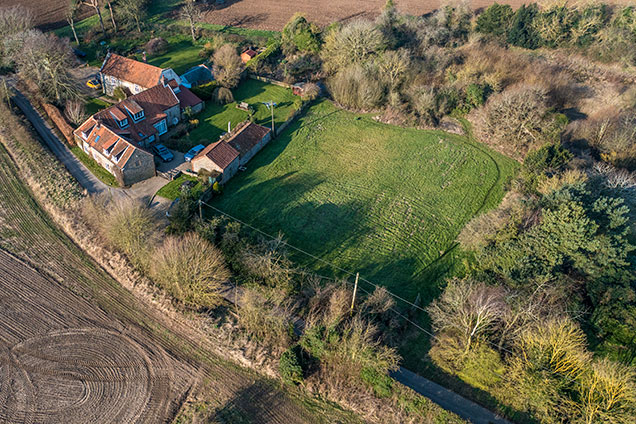 |
1952 |
11th March 2022 |
In 1926 Brownwood was bought by Mr Thomas Polding on early retirement from Lancashire. He wanted to get away from a wet climate to a drier country where he could fish, sail and enjoy rough shooting. Brownwood suited him perfectly for the latter and for the former he bought a fine cruiser on the Broads (which he could not operate without assistance) and a very fine car to get there (which he could not drive - though he had a chauffeur on occasion) . Sadly his wife died in 1927. Mr John A Hagen took over the tenancy on Mr Polding' s arrival - the farm previously having been farmed by his grandfather. When Mr Thomas Polding died in 1941, it was inherited by his daughter, Mrs Joan Watson-Cook and his son - but Mrs Watson-Cook bought out her brother's interest. Mrs Watson-Cook became something of a legend in her lifetime serving as County Councillor for Holt and District for twenty-two years from 1952 until her death in 1974. She was for many years a member of the Parish Council and the Erpingham Rural District Council, district organiser for the Red Cross, and prominent in the Womens Institute. In her obituary it was recorded that she was “a woman who held strong views and expressed herself wholeheartedly.'' She did not shy away from controversy and upset a number of friends by speaking out loudly against the destruction of trees and hedges and the loss of wildlife which characterised farming in the sixties and early seventies. She was particularly horrified by the massive hedge removals made by Mr David Johnson to Church_Farm across the road from her house. She was a prophet before her time. When her husband died in 1970, Mrs Watson-Cook wanted a neighbour and sold the barn (said to be older than the house - or at 1east to have in it some timber with dates on them which predated the house) to a friend, Mr John Clarke of Larners of Holt, who converted it. He sold it to Mr and Mrs Trollope, who later sold to the Duftons, who in turn sold it to the Buxtons in 1995. Hempstead, A Norfolk Village - Robin Carver, 2000 |
Mrs Watson Cook’s daughter, Mrs Diana Spalton, who with her brother was brought up at Brownwood, has very happy memories of her wartime childhood there. She attended Miss Preston's Orchard Nursery School in Hempstead Road, Holt - the school-run being shared with the Wilson boys from Hole_Farm. Petrol was very short - enough only for occasional shopping in Holt and most of the family travelling was in a pony and trap. Mrs Spalton can well remember paddling at Smokers_Hole, seeing the Cottage in which lived “Long_Sally”, catching freshwater clams in the Hempstead_Mill pond by putting down long sticks on which the clam shells would close, and skating on Selbrigg Pond. She can also remember the North Norfolk Coastal curfew imposed after Dunkirk. Everyone had to be in their houses by 9.30. It was then that the shed was built on Court Green to house the ARP. She also remembers the house shaking when G-mines were dropped three fields away on the Mack's farm (Hempstead Hall). Before the Poldings arrived Brownwood had been a fully equipped farm with dairy, very large barn, stable, loose-box, bullock yards and cart-shed. The dairy was then converted into what became the dining room and inevitably, with the conversion of the farm buildings into a house, the character of the rest of the farm buildings was lost. There was a raised threshing floor at the Duck House end of the barn under which was a herring-bone brick floor. There was also a search-light battery in the meadow when George Bachelor was machine-gunned when on top of the threshing tackle - the same time as the Baconsthorpe Rectory was bombed. |
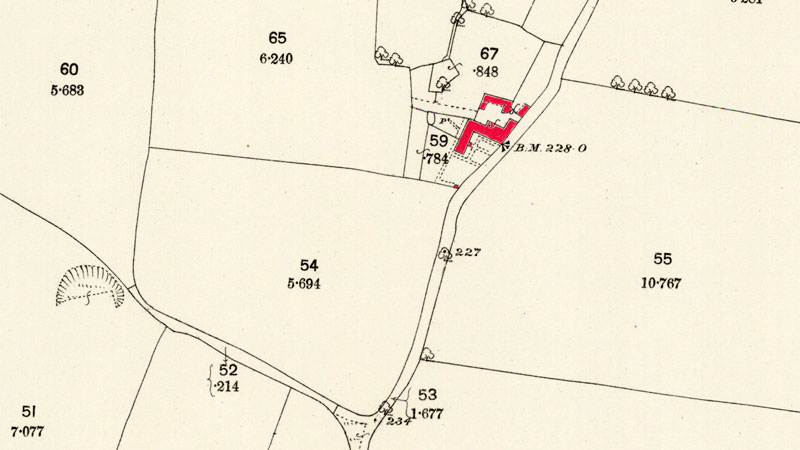 |
O. S. Map 1885 Brownwood Farm house and buildings shown in red Courtesy of NLS map images |
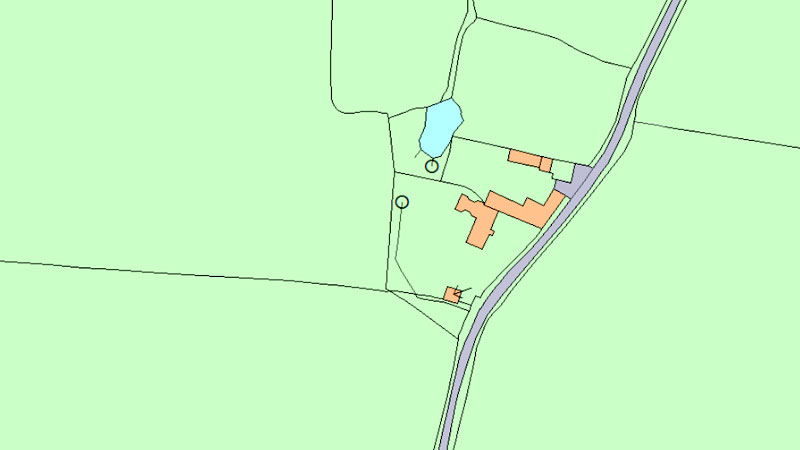 |
O. S. Map November 2023 Courtesy of Historic England map images |
| 1674: House built Will 24th July 1684: Nicholas Gotts bequeathed most of the property to son Owen Gotts with part to 2nd son Nicholas 16th April 1690: Owen Gotts sold Brownwood to Edmond Brightman 1694: James Tower of Edgefield foreclosed on the debt of the late Edmond Brightman acquiring Brownwood 10th October 1790: Mary Wrench granted a lease for 19 years to John Dagless at £35 10/- a year October 1795: Brownwood Farm sold to Francis Johnson, farmer of Cley for £1000 1830: William Ellis, tenant farmer Tithe Map 1841: Jeremiah Bond, tenant farmer 13th July 1866: Tenant farmer, Robert Bond bought the freehold
1916: Joseph Henry Morgan resident at Brownwood 8th March 1917: Joseph Henry Morgan died in a nursing home aged 45 years
Kelly's 1922: Bagge, Miss - Brownwood 1926: Brownwood bought by Thomas Polding and John A Hagen took over the tenancy Kelly's 1929: Polding, Thomas - Brownwood Kelly's 1933: Polding, Thomas - Brownwood 1941: Thomas Polding died and farm inherited by daughter Joan Watson-Cook
1995: Dufton family sold the barn to the Buxton family 2020: Keith & Jo Hurrell, Brownwood |
If you have any memories, anecdotes or photos please let us know and we may be able to use them to update the site. Please
or telephone 07836 675369 |
Website copyright © Jonathan Neville 2020 |